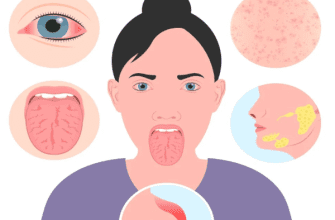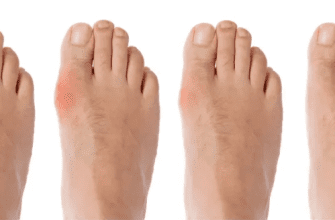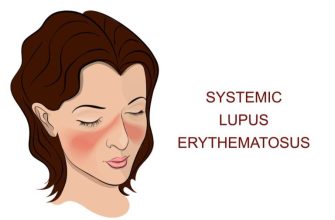What It Is
Systemic Sclerosis (SSc), often referred to simply as scleroderma, is a rare, chronic autoimmune disease. The name literally means “hard skin throughout the body.” It is characterized by three key features:
- Autoimmunity: The immune system becomes overactive and attacks the body’s own tissues.
- Widespread Fibrosis: Excessive production and buildup of collagen, a tough protein that makes up scar tissue, in the skin and internal organs.
- Vascular Damage: Injury to the small blood vessels, leading to poor blood flow.
Unlike localized scleroderma, which only affects the skin, systemic sclerosis can impact internal organs such as the heart, lungs, kidneys, and digestive system, making it a serious, multi-system disease.
Causes
The exact cause is unknown, but it is believed to result from a combination of factors:
- Genetic Predisposition: Certain genes make individuals more susceptible, but it is not directly inherited.
- Environmental Triggers: It is hypothesized that exposure to certain viruses, chemicals, or other environmental factors may trigger the disease in genetically susceptible people.
- Immune System Dysfunction: The immune system mistakenly targets connective tissue, causing inflammation and the activation of cells that produce excess collagen.
Symptoms
Symptoms vary dramatically from person to person but generally fall into a few categories:
- Raynaud’s Phenomenon: This is often the very first symptom. The fingers and toes turn white, then blue, and then red in response to cold or stress due to sudden blood vessel spasms. It can be painful.
- Skin Changes:
- Thickening, hardening, and tightening of the skin, often starting on the fingers and face.
- Shiny skin.
- Loss of skin folds.
- Small red spots (telangiectasias) on the face and hands.
- Sores or ulcers on the fingertips.
- Digestive System Symptoms:
- Heartburn (acid reflux) and difficulty swallowing due to esophageal involvement.
- Bloating, constipation, or diarrhea.
- Musculoskeletal Symptoms:
- Joint pain and stiffness.
- Muscle weakness.
- Lung Involvement: (A major cause of serious illness)
- Shortness of breath.
- A persistent dry cough.
- Interstitial Lung Disease (ILD) and Pulmonary Arterial Hypertension (PAH).
- Heart and Kidney Problems: Can lead to high blood pressure, irregular heartbeat, and in severe cases, a “scleroderma renal crisis” which is a medical emergency.
Diagnosis
Diagnosis is complex and requires a specialist, usually a rheumatologist.
- Thorough Medical History and Physical Exam: The doctor will look for characteristic skin changes, check for Raynaud’s, and listen to the heart and lungs.
- Blood Tests:
- Autoantibody Tests: The presence of specific antibodies is a key clue (e.g., ANA, Anti-Scl-70, Anti-Centromere). Different antibodies are associated with different subtypes and organ involvement.
- Imaging and Special Tests:
- Nailfold Capillaroscopy: A non-invasive microscope to look at the tiny blood vessels at the base of the fingernail, which often show changes specific to SSc.
- CT Scan of the Chest: To check for Interstitial Lung Disease.
- Echocardiogram: An ultrasound of the heart to assess its function and look for signs of Pulmonary Arterial Hypertension.
- Pulmonary Function Tests: To measure how well the lungs are working.
- Electrocardiogram (ECG/EKG): To check heart rhythm.
Treatment
There is no cure for systemic sclerosis, but treatments are highly effective for managing symptoms, slowing disease progression, and treating specific organ complications. Treatment is highly personalized.
- Disease-Modifying Therapies:
- Mycophenolate Mofetil or Cyclophosphamide: Used to treat interstitial lung disease and slow skin thickening.
- Organ-Specific Treatments:
- Raynaud’s & Ulcers: Calcium channel blockers (e.g., Nifedipine), ointments, and in severe cases, IV infusions.
- Heartburn/GERD: Strong acid-suppressing medications (PPIs).
- Kidney Involvement: ACE inhibitors are critical for preventing and treating scleroderma renal crisis.
- Pulmonary Arterial Hypertension: Specific medications that dilate lung blood vessels.
- Supportive Therapies:
- Physical and Occupational Therapy: To maintain skin and joint flexibility, improve strength, and teach energy conservation techniques.
- Skin Care: Regular moisturizing and protection from injury.
Prevention
There is no known way to prevent systemic sclerosis because the cause is not fully understood. The focus is on early diagnosis and aggressive management to prevent irreversible organ damage.
Prognosis
The prognosis for SSc has improved dramatically over the past few decades due to better treatments, especially for kidney crises and lung disease. It remains a serious condition, and the course is highly variable.
- Life expectancy depends on the extent and severity of internal organ involvement.
- Many people with limited disease have a normal or near-normal life span.
- Early and continuous specialist care is the most important factor for a better long-term outcome.
How to Know When to See a Doctor
You should see your doctor (who will likely refer you to a rheumatologist) if you experience a combination of the following, especially if they are persistent or worsening:
- Your fingers or toes turn white or blue, then red, in response to cold or stress (Raynaud’s phenomenon).
- You notice thickening, hardening, or tightness of the skin on your hands, fingers, or face.
- Persistent and often severe heartburn or difficulty swallowing.
- Unexplained shortness of breath or a persistent dry cough.
- Painful sores or pits on your fingertips.
- Significant and unexplained fatigue, joint pain, or muscle weakness.
Do not dismiss these symptoms, particularly Raynaud’s accompanied by skin changes. Early diagnosis and treatment are critical for managing systemic sclerosis and protecting your internal organs.






